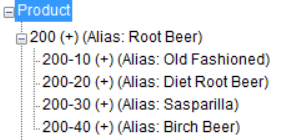Parent-Child References in Dimension Builds
When performing Essbase dimension builds, use a parent-child build method when every record of the source of data indicates a hierarchical relationship with a column of parent members and of child members, in that order.
Members in a database exist in a parent-child relationship. The image below shows part of the Product dimension with its parent and children relationships identified. Product is the parent of 100. 100 is the child of Product and the parent of 100-10, 100-10-12, and 100-10-16. 100-10, 100-10-12, and 100-10-16 are the children of 100.
Figure 14-5 Parents and Children

A parent-child source of data must contain at least two columns: a parent column and a child column, in that order. The source of data can include columns with other information (for example, the alias, the attributes, or the properties of the new member). A record within a parent-child source of data cannot specify multiple parents or multiple children, and cannot reverse the order of the parent and child columns.
In a parent-child build, the load rule specifies which column is the parent and which column is the child. For example, consider the source file (Dim_Product.txt), in which each record specifies the name of a parent and the name of its child, in that order.

The load rule (Dim_Product.rul) specifies which column is the parent and which column is the child. Additionally, this example associates aliases with the child field. Null fields, reserved for properties, are ignored.

Essbase builds the following hierarchy from the source data.

Note:
For duplicate member situations, the parent field must contain the qualified member name. See Build Qualified Member Names Using the Load Rule.